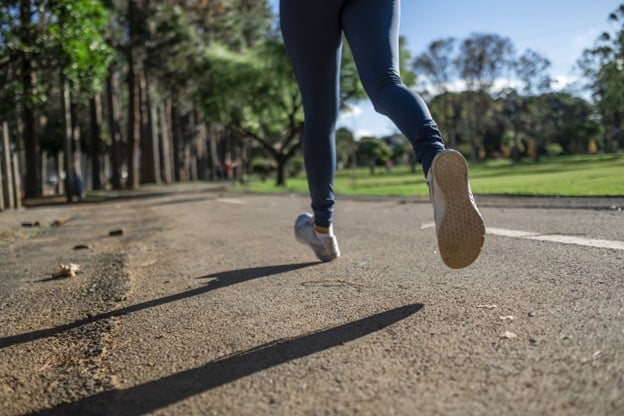Tips on How to Prevent Injuries When Jogging

WASHINGTON — Picture this: you’re out on a jog enjoying a lovely autumn day when you suddenly feel a twinge in your knee. You ignore it and decide to push through. Later, you’re in pain and regretting it. Eventually, you have to quit jogging until you heal. If this has happened to you, you’re not alone. Getting injured while jogging is common but preventable.
Jogging is a great way to get outside and get some cardio exercise, which has numerous physical and mental health benefits. Set yourself up to avoid injuries with our top tips: get the right shoes, learn the correct form, slowly progress, warm up, cool down and add resistance training.
Get the Right Footwear
The importance of jogging safety starts with your feet. Wearing the right shoes supports your feet and ankles. Here are four things to consider.
- Get Personalized Advice: Visit a professional running shoe store and ask an employee for guidance. They can analyze your natural walking pattern and suggest a brand or style.
- Consider Your Terrain: The soles of running shoes are designed for different terrains. Consider where you’ll be jogging to decide which shoe is best.
- Proper Sizing: Getting professionally measured helps ensure you wear the correct size.
- Look For a Wide Toe Box: Many shoes are narrow and push your toes together, which affects your mobility. Look for shoes with a wide toe box to allow your toes to spread naturally for a healthier stride.
Learn Proper Jogging Form
Jogging is a high-impact sport. It’s a repetitive, intense motion that causes shock to your joints. When done with improper form, it can lead to injury. Focus on aligning your joints, engaging your muscles, keeping an upright posture and breathing.
The correct jogging form may be different for each individual and working with a personal trainer or coach can be helpful. Here are some general tips to remember.
Foot Strike
Proper form starts when your foot touches the ground. Aim to hit the ground with your midfoot and push off your big-toe mound to propel yourself forward. Try to keep your foot neutral so it doesn’t pronate, or let your inner arches collapse.
Ankle, Knee and Hip Alignment
One common cause of jogging injuries is knee valgus. Knee valgus occurs when your knees cave in towards each other (or internally rotate). When you jog, your ankles, knees and hips should be neutral and in alignment. Externally rotate your hips to ensure your knees stay straight.
Stand Tall, Engage and Breathe
Maintain a tall posture as you jog. Engage your core to keep your spine straight and chest up. Actively squeeze your glutes as you move your legs. Focus on regular breathing, in and out, so your lungs can deliver oxygen to your muscles.
Gradually Progress Terrain
Practice your jogging form on a flat surface before changing your terrain. Jogging through the woods, on a trail, or uphill can be refreshing and enjoyable. However, the unpredictable terrain in these areas can increase your risk of injury.
- Outdoor Jogging: Practice in a flat area like a field or sidewalk. Focus on your foot stride and joint alignment.
- Treadmill Jogging: Learning to jog on a treadmill can be beneficial because you can control the speed and incline. A treadmill surface may be gentler on your joints.
When you’re ready to progress, hit a nature trail. Keep your skills in mind as you dodge rocks and other elements.
Warm Up and Cool Down
It’s important to warm up and cool down before and after any workout, including jogging. Warmups help prevent injury, and cooldowns help reduce stiffness.
Dynamic Warmup
Research shows doing a dynamic warmup before a workout helps prevent injury. It increases your heart rate, prepares your joints, engages your muscles and stimulates mental focus. A good warmup includes dynamic (or moving) stretches and light cardio. When you begin your jog, start slowly and gradually increase your speed.
Static Cooldown
A static stretch refers to holding a stretch without moving. Research shows static stretches are best after a workout. They may increase your range of motion and improve your recovery. Finish your jog by stretching your glutes, hamstrings, quads and calves.
Add Resistance Training to Your Routine
Resistance training is also key to injury prevention during jogging — here’s how it works.
Strengthens Your Muscles
Building muscle and strength in your lower body helps protect your joints. Focus on compound movements like deadlifts, squats, lunges and step-ups. Learning proper alignment in these exercises also carries over to jogging.
Increases Endurance
Doing bodyweight training or lifting weights builds muscular endurance. Research shows that building endurance through weightlifting carries over to cardiovascular endurance for aerobic exercise. More endurance allows you to jog longer before your muscles fatigue.
Builds Core Strength and Stability
Strengthening your core in resistance training improves your posture for jogging. You will also build core stability — the ability to resist spinal movements during exercise. As you jog, you’ll improve at engaging your abs to keep your spine neutral and avoid injuries during sudden movements.
Jog Smarter
It’s easy to overdo it on a jog, which takes you out of the game for longer than you’d like. Spend time getting the right shoes, learning proper form, practicing, warming up and cooling down. Follow a balanced exercise program that includes resistance training. You’ll be all set to enjoy beautiful jogs around the district, pain-free and with a lower risk of injury.
You can reach us at [email protected] and follow us on Facebook and Twitter
























